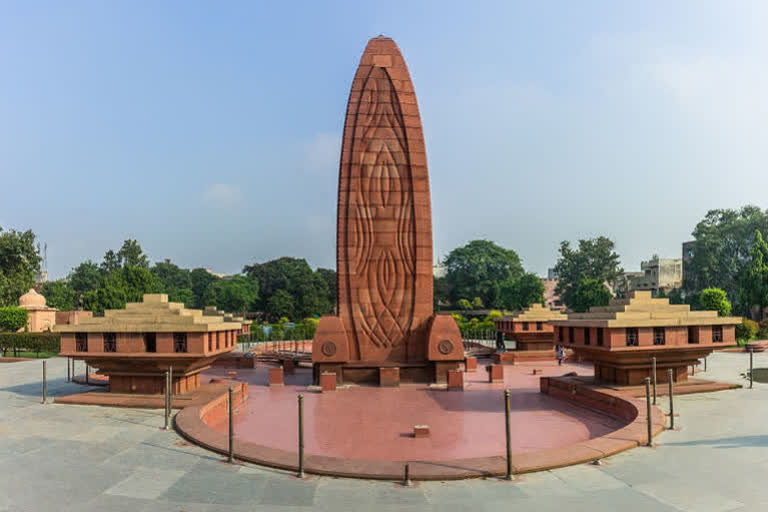Amritsar (Punjab): If there is a precise moment that clearly led the struggle for Indian Independence to fruition, it was the Jallianwala Bagh massacre on April 13, 1919. Much blood was shed in a single incident of otherwise non-violent struggle for the freedom from British and the blood-soaked floor and bullet-ridden walls shook the conscience of the leaders spearheading the movement. On this 75th year of Independence, let us pause to remember those innocent people butchered by the British autocracy.
Before the massacre, so much was brewing in the North-Western frontier of British India. The Gadar Movement of 1913 and the Komagata Maru incident of 1914 had started a wave of revolution among the people of Punjab. When the first World War broke out in 1914, many Indian soldiers were subjected to conscription in the fight against the German forces. Among the 1.95 lakh Indian soldiers in the British Army, 1 Lakh 10 thousand were from Punjab.
Nationalism and patriotism started gripping these soldiers who ventured out of the country for the first time and happened to see Europe. The British feared if these soldiers revolt, it would be difficult to control them. Given the changing environment in Punjab, the British came up with the contentious Rowlatt Act. Protests against the draconian law erupted in different parts when the local press started discussing it in detail. Protests took place in many parts of Punjab, including Amritsar. Despite the widespread protests, Rowlatt Act was passed on March 18, 1919.
According to Prof. Prashant Gaurav, two leaders namely Dr. Satyapal Malik and Dr Saifuddin Kichlew were prominent in these protests. There was also an attempt to rope in Mahatma Gandhi to strengthen the protest. However, Gandhi was stopped at Palwal on his way to Punjab on 2 April 1919. Sensing trouble, the British decided to trap these two leaders spearheading the protests. Amritsar District Commissioner, Miles Irving called Satyapal and Kichlew to his office on April 10, 1919 but arrested them. They were moved away from Amritsar and lodged in a house arrest at Dharmashala.
Tensions simmered in Amritsar after the arrest of these two senior leaders. More than 20,000 people protested in Katra Jaimal Singh, Hall Bazaar and Ucha Pul area. After one or two violent incidents, Lieutenant Governor of Punjab Michael O' Dwyer had called Army officer General R. H. Dyre from Jalandhar Cantonment board to handle the situation. Dyre on his part had a detrimental view about Indians, said Gaurav.
A day before the Jallianwala Bagh massacre, General Reginald Dyre marched in Amritsar with his entire armed forces and announced a curfew. Sadly, most of the local residents did not even know about the curfew. Unaware of the curfew, people gathered for a meeting at Jallianwala Bagh. Apart from this, on the day of Vaisakhi, the Sangat from far had reached Sri Harmandir Sahib to pay homage. Traders coming to participate in Gobindgarh Pashu Mela were also present there.
Read: How fiery Jharkhand Tribals forced the British Army to drop their weapons
When the preparations for the protest was made in Jallianwala Bagh, the British officers thought the protesters would turn against them. The meeting which was scheduled between 4 and 4.30pm started at 3pm considering the huge crowd. All this while, Dyer was getting every update from the people posted on the ground.
Around 5.15pm General Dyre reached Jallianwala Bagh with four detachments of 25 soldiers. With 50 soldiers of Gorkha Regiment and Afghan Regiment, General Dyre entered the area and immediately ordered to shoot. The firing started precisely at 5.30 pm, said, Professor Prashant Gaurav. There were no warning shots fired or efforts made to disperse the crowd. People were shot directly and 1,650 rounds of .303 calibre were fired and people started falling dead.
When people saw the dead and wounded, a stampede started as people tried to flee the bullets. The well inside the ground was filled with dead bodies. Initially, O' Dwyre reported 200 were killed out of 5,000 people present in the ground. Punjab Chief Secretary J.P. Thomson wrote that 291 people were killed, among which 211 were of Amritsar city. Hunter committee said that 379 people were killed. The numbers are strange and they need a thorough clarification, added Gaurav.
Madan Mohan Malviya was head of the Inquiry Committee and he said that 1,000 people got killed. Congress Inquiry Committee said that 1,200 people were killed and 2,600 were injured. Swami Shradhanand who went there had said that 1,500 people died. "So in total, the data is in between 1000-1500. It is Britisher's record that kept on increasing but 379 is not right in any way. Overall it can be said that how many people got killed is not clear but one thing is for sure that thousands of people got killed," Gaurav said.
After the outrage of the Indians, the white government had to suspend General Dyer, who quietly returned to Britain. Shaheed Udham Singh avenged the massacre by shooting Michael O'Dwyer in London on March 13, 1940. In 1961, the Government of India erected a memorial to pay homage to departed souls, which was inaugurated by the first president of Free India, Dr Rajendra Prasad.
Read: Ajmer Fort, a unique memorial of India's freedom struggle



